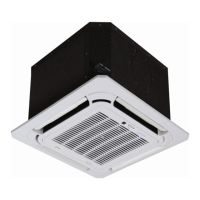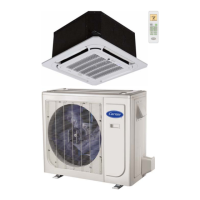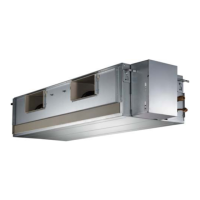32
Electronic Expansion Valve (EXV)
Control
1 EXV will be fully closed when turning on the power. Then
EXV will be standby with 350P open and will open to
target angle after compressor starts.
2 EXV will close with -- 160P when compressor stops. Then
EXV will standby with 350P open and then opens to target
angle after compressor starts.
3 The action priority of the EXVs is A--B--C--D.
4 Compressor and outdoor fan start operation only after EXV
is initialized.
Cooling
mode
1 The initial open angle of EXV is 250P, adjustment range is
100-- 350p. When the unit start to work for 3 minutes, the
outdoor will receive indoor units (of capacity demand) T2B
information and calculate the average of them. After
comparing each indoor’s T2B with the average. the outdoor
gives the following modification commands: If the
T2B>average, the relevant valve needs more 16p open. If
the T2B = average, the relevant valve’s open range remains.
If the T2B<average, the relevant valve needs more 16p
close. This modification will be carried out every 2 minutes.
6.4.4.2 Heating
mode
The initial open angle of EXV is 250P, adjustment range is
100-- 350p. When the unit start to work for 3 minutes, the outdoor
will receive indoor units (of capacity demand) T2 information and
calculate the average of them. After comparing each indoor units’
T2 with the average, the outdoor unit gives the following
modification commands. If the T2<average +2, the relevant valve
needs more 16p close. If average +2
≥the T2≥ average--2, the
relevant valve’s open range remains. If the T2< average-- 2, the
relevant valve needs more 16p open. This modification will be
carried out every 2 minutes.
6.4.5 Four--way valve
control
In heating mode, four-- way valve is opened. In defrosting, the
four--way valve operates in according to defrosting action. In other
modes, the four--way valve is closed. When the heating mode to
other modes, the four--way valve is off after compressor is off for 2
minutes. Failure or protection (not including discharge temperature
protection, high and low pressure protection), four-- way valve
immediately shuts down.
TROUBLESHOOTING
This section provides the required flow charts to troubleshoot
problems that may arise.
NOTE: Information required in the diagnoses can be found
either on the wiring diagrams or in the appendix.
Required
Tools:
The following tools are needed when diagnosing the units:
S Digital multimeter
S Screw drivers (Phillips and straight head)
S Needle--nose pliers
S Refigeration gauges
Recommended
Steps
1 Refer to the diagnostic hierarchy charts below and
determine the problem at hand.
2 Go to the chart listed in the diagnostic hierarchy and follow
the steps in the chart for the selected problem.
For the ease of service, the systems are equipped with diagnostic
code display LED’s on both the indoor and outdoor units. The
outdoor diagnostic display is on the outdoor unit board and is
limited to very few errors. The indoor diagnostic display is a
combination of flashing LED’s on the display panel on the front of
the unit. If possible always check the diagnostic codes displayed on
the indoor unit first.
The diagnostic codes for the indoor and outdoor units are listed in
the appendix.
Problems may occur that are not covered by a diagnostic code, but
are covered by the diagnostic flow charts. These problems are
typical air conditioning mechanical or electrical issues that can be
corrected using standard air conditioning repair techniques.
For problems requiring measurements at the control boards, note
the following:
1 Always disconnect the main power.
2 When possible check the outdoor board first.
3 Start by removing the outdoor unit top cover.
4 Reconnect the main power
5 Probe the outdoor board inputs and outputs with a digital
multi--meter referring to the wiring diagrams.
6 Connect the red probe to hot signal and the black probe to
the ground or negative.
7 Note that some of the DC voltage signals are pulsating
voltages for signal. this pulse should be rapidly moving at
all times when there is a signal present.
8 If it is necessary to check the indoor unit board you must
start by disconnecting the main power.
9 Next remove the front cover of the unit and then control
box cover.
10 Carefully remove the indoor board from the control box,
place it face up on a plastic surface (not metal).
11 Reconnect the main power and repeat steps 5, 6, and 7.
12 Disconnect main power before reinstalling board to avoid
shock hazard and board damage.

